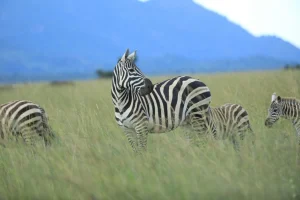Toro Semliki Wildlife Reserve
Uganda’s safari scene is often dominated by the spotlight of its mountain gorillas, dramatic waterfalls, and savannah plains. Yet, hidden in the quiet corners of western Uganda lies a truly unspoiled treasure Toro Semliki Wildlife Reserve. This vast expanse of wilderness is Uganda’s oldest protected area and offers an off-the-beaten-path safari experience unlike anywhere else in the country.
Whether you are a seasoned safari-goer seeking something unique, a birder hunting for rare species, or a traveler looking to connect with nature and culture away from the crowds, Toro-Semliki deserves a top spot on your itinerary. In this guide, we explore everything you need to know about this hidden gem—from its location and wildlife to the best time to visit and how to get there.
Where is Toro-Semliki Wildlife Reserve Located?
Toro-Semliki Wildlife Reserve is located in western Uganda, straddling the districts of Ntoroko and Kabarole. It sits within the scenic Albertine Rift Valley, nestled between Lake Albert to the north and the majestic Rwenzori Mountains to the south. The nearest major town is Fort Portal, about 55 kilometers away, making it an accessible yet peaceful escape into Uganda’s untouched wild.
This reserve covers approximately 542 square kilometers and serves as a critical ecological corridor between forest and savannah environments. Its strategic location enhances its biodiversity, supporting a wide range of flora and fauna.
What Makes Toro-Semliki Unique?
What sets Toro-Semliki Wildlife Reserve apart is its diversity. The terrain transitions from open acacia savannah to Borassus palm forest, riparian woodlands, wetlands, and dense riverine thickets. These varied habitats attract both forest and savannah species, creating a rare blend of wildlife in one compact location.
Established in 1926, it was originally designated to protect the Uganda kob, a species of antelope that still thrives here today. Over time, the reserve has become a haven for many other species, offering excellent game viewing and birding opportunities with far fewer tourists than Uganda’s more famous national parks.
What Wildlife Can You See in Toro-Semliki?
Despite its underrated status, Toro-Semliki is incredibly rich in wildlife. Visitors often spot:
- Uganda kobs, often in large herds
- Savannah and forest elephants
- Waterbucks
- Warthogs
- African buffalo
- Giant forest hogs
- Bushbucks
The reserve also supports predators like leopards, jackals, and hyenas, though sightings can be rare due to the reserve’s vast size and thick vegetation.
One of the most exciting features of Toro-Semliki is its primates. The Mugiri River Forest, within the reserve, is home to a semi-habituated community of about 70 chimpanzees. Other primate species include olive baboons, red-tailed monkeys, vervet monkeys, and black-and-white colobus monkeys.
Is Toro-Semliki Good for Bird Watching?
Absolutely. With over 460 recorded bird species, Toro-Semliki is a true paradise for birders. The reserve’s position in the Albertine Rift Valley makes it a crucial birding site for both East African and West African bird species.
Birders often hope to spot the shoebill stork, one of the world’s most sought-after birds. Other commonly observed species include:
- Red-throated bee-eaters
- Abyssinian ground hornbills
- African fish eagles
- Palm-nut vultures
- Various sunbirds and weavers
Bring binoculars and a good bird guide, because the opportunities here are as rich as they are rewarding.
What Activities Can You Do in Toro-Semliki?
Toro-Semliki may be remote, but it offers a well-rounded set of activities that cater to various interests:
1. Game Drives
Explore the vast savannah and wooded areas in a 4×4 vehicle, especially in the early morning or late afternoon when animals are most active.
2. Primate Tracking
Take a guided walk into the Mugiri Forest and track the resident chimpanzees. Though not as established as in Kibale, this experience offers an authentic, wild adventure.
3. Bird Watching
Thanks to its ecosystems, birdwatching is excellent year-round. Both casual and professional birders will find exciting species in a single morning.
4. Boat Safaris on Lake Albert
While not as common, some tours include boat trips on Lake Albert, which borders the northern edge of the reserve. These offer additional birding and the chance to spot hippos and crocodiles.
5. Nature Walks and Hiking
Guided nature walks provide an immersive experience in the bush. Learn about medicinal plants, track animals, and enjoy the quiet of nature uninterrupted.
6. Cultural Visits
Nearby communities, such as the Karugutu Conservation Association, welcome visitors to learn about traditional practices, participate in dances, and understand the local conservation ethos.
How to Get to Toro-Semliki Wildlife Reserve?
You can access Toro-Semliki by road or air:
- By Road: From Fort Portal, the reserve is about 55 kilometers away, reachable via a scenic drive that passes through rolling hills and lush tea plantations. The journey takes approximately 1.5 to 2 hours on mostly good roads.
- By Air: You can charter a flight to Semliki Airstrip, which is just a short distance from most lodges. This is the fastest and most convenient option for high-end travelers.
Whether you’re coming from Kampala, Murchison Falls, or Queen Elizabeth National Park, Toro-Semliki can easily be integrated into a larger Uganda safari circuit.
Where to Stay in Toro-Semliki?
Accommodation within and around Toro-Semliki ranges from budget to luxury. While options are limited compared to bigger parks, the ones available offer a genuine wilderness experience.
- Semliki Safari Lodge: A high-end tented lodge offering comfort, privacy, and top-notch hospitality.
- UWA Bandas and Campsites: Budget-friendly options managed by Uganda Wildlife Authority.
- Nearby Guesthouses: Several guesthouses in Fort Portal or Karugutu cater to travelers looking for affordable stays.
Most lodges offer guided activities, meals, and transport arrangements, so you can focus on enjoying your adventure.
When Is the Best Time to Visit Toro-Semliki?
Toro-Semliki can be visited year-round, but the dry seasons (December to March and June to August) are generally the best for wildlife viewing and ease of travel.
The reserve has a warm climate, with average daytime temperatures around 30°C (86°F). Rain can fall unexpectedly, especially during the wet seasons (April–May and September–November), but it rarely disrupts activities entirely.
Is Toro-Semliki Worth Visiting?
Absolutely. If you’re looking for a safari destination that combines wildlife, birding, primates, and culture—without the tourist crowds—Toro-Semliki Wildlife Reserve is a superb choice. Its location makes it perfect for travelers heading to or from Fort Portal, Kibale Forest, Queen Elizabeth National Park, or even Murchison Falls.
Toro-Semliki allows you to slow down, connect with nature on a deeper level, and experience a side of Uganda that few visitors get to see.
Final Thoughts
Toro-Semliki Wildlife Reserve is a hidden gem that showcases the untamed spirit of Uganda. From the golden grasses of its savannahs to the mysterious depths of its riverine forests, the reserve captures the heart of any traveler willing to step off the main trail.
Its rich biodiversity, remote setting, and authentic experiences offer something for everyone—especially those seeking solitude, unique wildlife sightings, and a deeper connection with Uganda’s wilderness.
If you’re building an itinerary that goes beyond the obvious, make space for Toro-Semliki. It may just be the highlight of your trip.




